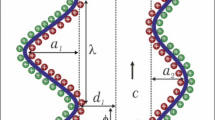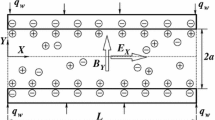Abstract
In this paper, the heat transfer characteristics of the nanofluid through a parallel plate soft nanochannel are investigated under the fully developed condition. The flow is actuated by the combined effects of pressure gradient and implied electric field. Based on the ion partitioning effect and the Debye–Hückel linearization, the analytical solutions for electrokinetic flow in such nanochannel are obtained. Meanwhile, the uniform wall heat flux is utilized in the analysis, and the influences of viscous dissipation and the Joule heating are taken into account. The results for pertinent dimensionless parameters are presented graphically and discussed in brief. The relevant result reveals that the ion partitioning effect can greatly impact the electrostatic potential, velocity and temperature distribution. Furthermore, this ion partitioning effect can exert an influence on heat transfer of the nanofluid. The present study also indicates the possibility of alteration in the nanofluid heat transfer by the use of nanoparticle volume.








Similar content being viewed by others
References
Becker H, Gartner C. Polymer microfabrication methods for microfluidic analytical applications. Electrophoresis. 2000;21:12–26.
Ohno K, Tachikawa K, Manz A. Microfluidics: applications for analytical purposes in chemistry and biochemistry. Electrophoresis. 2008;29:4443–53.
Nandy K, Chaudhuri S, Ganguly R, Puri IK. Analytical model for the magnetophoretic capture of magnetic spheres in microfluidic devices. J Magn Magn Mater. 2008;320:1398–405.
Maynes D, Webb BW. Fully developed thermal transport in combined pressure and electro-osmotically driven flow in microchannels. ASME J Heat Transfer. 2003;125:889–95.
Horiuchi K, Dutta P. Joule heating effects in electroomotically driven microchannels. Int J Heat Mass Transf. 2004;47:3085–95.
Haque A, Nayak A K. Mixed electroosmotic pressure driven flow and heat transfer of power law fluid in a hydrophobic microchannel. In: ASME 2017 Fluids Engineering Division Summer Meeting. American Society of Mechanical Engineers, American; 2017. p. V01BT10A017-V01BT10A017.
Su J, Jian YJ, Chang L. Thermally fully developed electroosmotic flow through a rectangular microchannel. Int J Heat Mass Transf. 2012;55:6285–90.
Makino K, Ohshima H. Soft particle analysis of electrokinetics of biological cells and their model systems. Sci Technol Adv Mater. 2011;12:1–13.
Lee J, Panzer MJ, He Y, Lodgeand TP, Frisbie CD. Ion Gel Gated Polymer Thin-Film Transistors. J Am Chem Soc. 2007;129:4532–3.
Kim B, Heo J, Kwon HJ, Cho SJ, Han J, Kim SJ, Lim G. Tunable ionic transport for a triangular nanochannel in a polymeric nanofluidic system. ACS Nano. 2012;7:740–7.
Huh D, Mills KL, Zhu X, Burns MA, Thoulessand MD, Takayama S. Tuneable elastomeric nanochannels for nanofluidic manipulation. Nat Mater. 2007;6:424–8.
Wei C, Bard AJ, Feldberg SW. Current rectification at quartz nanopipet electrodes. Anal Chem. 1997;69:4627–33.
Donath E, Voigt E. Streaming current and streaming potential on structured surfaces. J Colloid Interface Sci. 1986;109:122–39.
Ohshima H, Kondo T. Electrokinetic flow between two parallel plates with surface charge layers: electro-osmosis and streaming potential. J Colloid Interface Sci. 1990;135:443–8.
Keh HJ, Ding JM. Electrokinetic flow in a capillary with a charge-regulating surface polymer layer. J Colloid Interface Sci. 2003;263:645–60.
Ma HC, Keh HJ. Diffusioosmosis of electrolyte solutions in a capillary slit with adsorbed polyelectrolyte layers. J Colloid Interface Sci. 2007;313:686–96.
Chanda S, Sinhab S, Das S. Streaming potential and electroviscous effects in soft nanochannels: towards designing more efficient nanofluidic electrochemomechanical energy converters. Soft Matter. 2014;10:7558–68.
Chen G, Das S. Streaming potential and electroviscous effects in soft nanochannel beyond Debye–Hückel linearization. J Colloid Interface Sci. 2015;445:357–63.
Chen G, Das S. Electroosmotic transport in polyelectrolyte-grafted nanochannels with PH-dependent charge density. J Appl Phys. 2015;117:185304.
Patwary J, Chen G, Das S. Efficient electrochemomechanical energy conversion in nanochannels grafted with polyelectrolyte layer with PH-dependent charge density. Microfluid Nanofluid. 2016;20:1–14.
Matin MH, Ohshima H. Combined electroosmtically and pressure driven flow in soft nanofluidics. J Colloid Interface Sci. 2015;460:361–9.
Matin MH, Ohshima H. Thermal transport characteristics of combined electroosmotic and pressure driven flow in soft nanofluidics. J Colloid Interface Sci. 2016;476:167–76.
Li FQ, Jian YJ, Chang L, Zhao GP, Yang LG. Alternating current electroosmotic flow in polyelectrolyte-grafted nanochannel. Colloid Surf B. 2016;147:234–41.
Li FQ, Jian YJ, Xie ZY, Liu YB, Liu QS. Transient alternating current electroosmotic flow of a Jeffrey fluid through a polyelectrolyte-grafted nanochannel. RSC Adv. 2017;7:782–90.
Xing J, Jian Y. Steric effects on electroosmotic flow in soft nanochannels. Meccanica. 2018;53(1–2):135–44.
Poddar A, Maity D, Bandopadhyay A, Chakraborty S. Electrokinetics in polyelectrolyte grafted nanofluidic channels modulated by the ion partitioning effect. Soft Matter. 2016;12(27):5968–78.
Hedayati F, Malvandi A, Kaffash MH, Ganji DD. Fully developed forced convection of alumina/water nanofluid inside microchannels with asymmetric heating. Powder Technol. 2015;269:520–31.
Ahammed N, Asirvatham LG, Wongwises S. Effect of volume concentration and temperature on viscosity and surface tension of graphene–water nanofluid for heat transfer applications. J Therm Anal Calorim. 2016;123(2):1399–409.
Mashaei PR, Shahryari M, Madani S. Numerical hydrothermal analysis of water-Al2O3 nanofluid forced convection in a narrow annulus filled by porous medium considering variable properties. J Therm Anal Calorim. 2016;126(2):891–904.
Sheikholeslami M, Hatami M, Ganji DD. Nanofluid flow and heat transfer in a rotating system in the presence of a magnetic field. J Mol Liq. 2014;190:112–20.
Mahian O, Pop I, Sahin AZ, Oztop HF, Wongwises S. Irreversibility analysis of a vertical annulus using TiO2/water nanofluid with MHD flow effects. Int J Heat Mass Transf. 2013;64:671–9.
Hedayati F, Domairry G. Effects of nanoparticle migration and asymmetric heating on mixed convection of TiO2–H2O nanofluid inside a vertical microchannel. Powder Technol. 2015;272:250–9.
Ganguly S, Sarkar S. Thermally developing combined electroosmotic and pressure-driven flow of nanofluid in a microchannel under the effect of magnetic field. Chem Eng Sci. 2014;126:10–21.
Sarkar S, Ganguly S. Fully developed thermal transport in combined pressure and electroosmotically driven flow of nanofluid in microchannel under the effect of a magnetic field. Microfluid Nanofluid. 2015;18:623–36.
Malvandi A, Ganji DD. Magnetic field effect on nanoparticles migration and heat transfer of water/alumina nanofluid in channel. J Magn Magn Mater. 2014;362:172–9.
Turkilmazoglu M. Exact analytical solutions for heat and mass transfer of MHD slip flow in nanofluids. Chem Eng Sci. 2012;84:182–7.
Torabi M, Dickson C, Karimi N. Theoretical investigation of entropy generation and heat transfer by forced convection of copper–water nanofluid in a porous channel: local thermal non-equilibrium and partial filling effects. Powder Technol. 2016;301:234–54.
Dickson C, Torabi M, Karimi N. First and second law analyses of nanofluid forced convection in a partially-filled porous channel – The effects of local thermal non-equilibrium and internal heat sources. Appl Therm Eng. 2016;103:459–80.
Ting TW, Hung M, Guo N. Viscous dissipative forced convection in thermal non-equilibrium nanofluid-saturated porous media embedded in microchannels. Int Commum Heat Mass Transf. 2014;57:309–18.
Acknowledgements
The work was supported by the National Natural Science Foundation of China (Grant Nos. 11472140, 11772162), the Natural Science Foundation of Inner Mongolia Autonomous Region of China (Grant No. 2016MS0106), the Foundation of Inner Mongolia Autonomous Region University Scientific Research Project (Grant No. NJZY18093), the Foundation of Inner Mongolia University of Technology (Grant No. ZD201714) and the Inner Mongolia Grassland Talent (Grant No. 12000-12102013).
Author information
Authors and Affiliations
Corresponding author
Appendix
Appendix
The coefficients in Eqs. (41) and (42) are presented as follows:
where \( K_{1} = 0 \), \( K_{2} = f_{2} (\bar{d} - 1) - f_{2} ( - 1) - f_{1} (\bar{d} - 1) \), \( K_{3} = \frac{{{\text{d}}f_{1} (\bar{y})}}{{{\text{d}}\bar{y}}}\left| {_{{\bar{y} = - 1 + \bar{d}}} } \right. - g(\bar{y})\left| {_{{\bar{y} = - 1 + \bar{d}}} } \right. \), \( K_{4} = - f_{2} ( - 1) \), and \( g(\bar{y}) = \frac{{{\text{d}}f_{2} (\bar{y})}}{{{\text{d}}\bar{y}}} - K_{3} \).
Rights and permissions
About this article
Cite this article
Zhao, G., Jian, Y. Thermal transport of combined electroosmotically and pressure driven nanofluid flow in soft nanochannels. J Therm Anal Calorim 135, 379–391 (2019). https://doi.org/10.1007/s10973-018-7326-4
Received:
Accepted:
Published:
Issue Date:
DOI: https://doi.org/10.1007/s10973-018-7326-4




